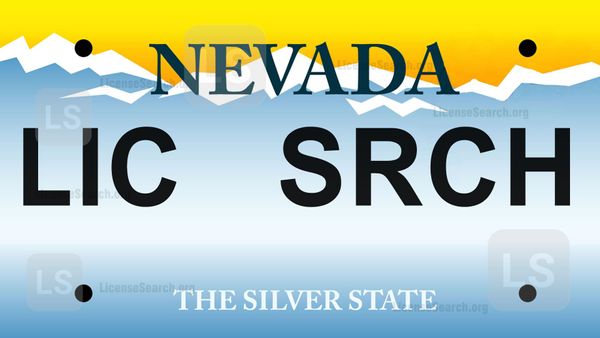
Nevada License Plate Lookup
Since 1916 Nevada or “The Silver State” started issuing license plates. Since then, the Nevada Department of Motor Vehicles (DMV) issues the license plates. So, make sure you have a license plate before you drive your vehicle on the roads and highways.
The residents of Nevada can easily register their cars at the Nevada Department of Motor Vehicles. If you are a new resident, you will be given 30 days to establish your residency. You might need to submit proof of your identity and residency (you can use your driver’s license for that).
Currently, the NV DMV issues two license plates to be displayed. The first one is for the front, and the other one is for the rear of the vehicle. It does not apply to motorcycles and trailers, as they only need a rear license plate.
Applying for License Plates in Nevada
When you apply for a license plate, you must first register your car in Nevada. You must book an online appointment in advance. This can be done via the DMV official website.
Those, who are new to Nevada, must obtain a Nevada driver’s license first. Then, they will have 30 days (after establishing residency) to register their vehicle. They must submit some documents, including the filled-out application form. Not to forget about paying the registration fee.
If you want to use your vehicle before the arrival of your license plate, you can get a temporary tag. Your veհicle seller gives it to you. On the whole, you can apply for a temporary tag at the state DMV office. It is also possible to renew tags in Nevada.
Types of Nevada License Plates
Nevada offers different kinds of license plates according to some circumstances. The classic plates in Nevada are standard passenger plates. There are also other types:
- Personalized Plates
These are the standard specialty plates. You must fill out the required application form and submit it at the DMV. You may also send it by mail. Accordingly, you will get a notice when your plates are ready. You will need your current application and state-issued car insurance. Personalized plates have up to 6 or 7 letters. They should not contain prejudice against gender, race, religion, improper and illegal content․ - Collegiate and Charitable Plates
With the help of these plates, you can show your support for special occasions, charities, and institutions. You can obtain either a standard plate or a personalized one. The plate fee may differ based on the type of charitable plate you want. However, the standard plate fee varies from $51 to $61. For personalized plates, you should pay an extra fee. - Military and Veterans Plates
For those people who serve/used to serve in the army, navy, air force, corps, or their family members (child/parent/spouse). Veterans should submit the veteran’s license plate application at the DMV. The personalized version of the military plates is available.
Other types of specialty plates
- Disability Plates
Disabled veterans can purchase disability plates at a lower price. The fee is $7 (only two types of it cost $26). Disability plates are impossible to personalize. - Organizational Plates
The plates are for people working at different organizations, such as firefighters, press, amateur radio operators, etc. You should submit confirmation of your eligibility (for example, evidence of employment). The personalized version of some types of organizational plates is available. - Classic and Vintage Plates
These are for vehicles manufactured earlier than 1949. Being that, fire trucks, antique trucks, or other vintage vehicles. You must submit proof of your disability, of course, when it is caused on active duty or service.
NV DMV may refuse some applications, for more information visit our banned Nevada license plates page.
License Plate Fees in Nevada
In the case of all types of passenger cars and motorcycles, the registration fee in Nevada is $33. Even so, you should also pay a $6 safety fee for motorcycles. Nevada also demands a Governmental Services Tax. Some of the counties even charge a Supplemental Governmental Services Tax. The registration fee for travel trailers is $27.
The license plate replacement fee differs according to what type of plates you want. If you want a new license plate with a new number the fee is $5. You must also pay a $0.50 Prison Industries Fee. But, in case you apply for duplicated plates with the same number you should pay $17 for plates, plus a $3 fee for each plate production and a $0.50 Prison Industries fee for each plate. Money orders can be done by cash, credit, VISA/MasterCard.
How to replace a Nevada License Plate
License plates can be replaced in Nevada if you have lost or damaged them. You can obtain either a new license plate or the same one with old numbers. In case someone steals your license plate, you must get a new one. In both cases, you should submit an application form and pay the replacement fee.
You can request a replacement registration in person or by fax. Also, you will need the completed application for Duplicate Certificate of Registration and/or Substitute Decal and proof of insurance. If you want to fax your request, you must as well submit the completed copy of the Payment Authorization, along with the insurance card and application.
Smog Check
Nevada law requires a smog check each year. You can accomplish the test before the registration renewal notice. Those, who have recently moved to Nevada, should do the smog check. They must also complete emissions inspections before registering their vehicles within 30 days.
Some vehicles need an emissions test if they are:
- Gasoline-powered
- Diesel-powered (the vehicle’s weight should be up to 14000 pounds)
- The model year of 1968 or newer
- Based in the urban parts of Washoe or Clark County
- Done with two registrations
These tests are valid for 90 days. But if you buy a car from a Nevada dealer, then you will have 180 days after testing. Test fees change every year. Therefore, so you should check them on the DMV site.
Nevada Kiosks
In Nevada, you can come across several available, self-service kiosks. They can help you complete a lot of deals. You will be able to get the printout of your plate decal or driver history in a few seconds.
The kiosk offers different services. They include license plate renewal, duplicate registration or decal, driver history printout, etc. You can do registration renewal and duplicates with a $3 fee. All the other transactions cost $1. These services are available online, too.
License Plate Renewal
As a rule, you will get a renewal notice about 30 days before the registration expires. It is possible to renew your registration before the date of expiration. It is advisable to apply for license renewal in person. You must submit your driver’s license and proof of car insurance. The Nevada car registration renewal fee is $33. However, the fee is not fixed for all vehicles. You can pay by cash, Visa/MasterCard.
You may do this either by mail or online. To renew your registration online, you should provide some car identification details. This may include the previous 4 digits of the VIN and license plate number. You can even simply use the renewal notice entrance code. Then, you should pay the renewal fee. The calculated version of the registration renewal will appear on your screen and confirm all the information in the end.
Additional Information
When you buy a new car, you can transfer your current license plates while registering them at the DMV. This means that you can transfer the ownership of the vehicle to its new owner. Otherwise, you must surrender your license plates after selling your car.
When you are in a place where the law requires emissions testing, you must have an accomplished test. In case of testing is not required, you should complete the Emission Control Exemption application form. Afterward, present it with all the necessary documents. Thereby, you will make an out-of-state renewal before you arrive.
There is not a favored date on expired registrations. On the contrary, you must renew them at the right time. You can check the status of your license plate through the Online Registration and Insurance Status Inquiry. Nevada law requires levying late fees made out of penalties and taxes. Thus, you must pay all the renewal and registration fees.
In addition, you must affirm your tax exemption when you register or renew your car.
